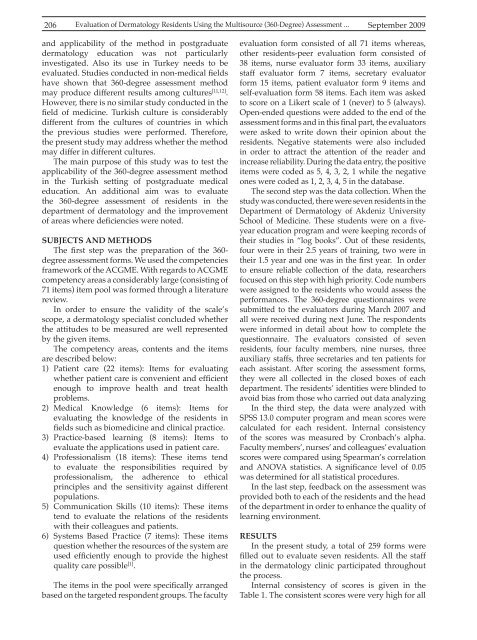Vol 41 # 3 September 2009 - Kma.org.kw
Vol 41 # 3 September 2009 - Kma.org.kw
Vol 41 # 3 September 2009 - Kma.org.kw
Create successful ePaper yourself
Turn your PDF publications into a flip-book with our unique Google optimized e-Paper software.
206<br />
Evaluation of Dermatology Residents Using the Multisource (360-Degree) Assessment ...<br />
<strong>September</strong> <strong>2009</strong><br />
and applicability of the method in postgraduate<br />
dermatology education was not particularly<br />
investigated. Also its use in Turkey needs to be<br />
evaluated. Studies conducted in non-medical fields<br />
have shown that 360-degree assessment method<br />
may produce different results among cultures [11,12] .<br />
However, there is no similar study conducted in the<br />
field of medicine. Turkish culture is considerably<br />
different from the cultures of countries in which<br />
the previous studies were performed. Therefore,<br />
the present study may address whether the method<br />
may differ in different cultures.<br />
The main purpose of this study was to test the<br />
applicability of the 360-degree assessment method<br />
in the Turkish setting of postgraduate medical<br />
education. An additional aim was to evaluate<br />
the 360-degree assessment of residents in the<br />
department of dermatology and the improvement<br />
of areas where deficiencies were noted.<br />
SUBJECTS AND METHODS<br />
The first step was the preparation of the 360-<br />
degree assessment forms. We used the competencies<br />
framework of the ACGME. With regards to ACGME<br />
competency areas a considerably large (consisting of<br />
71 items) item pool was formed through a literature<br />
review.<br />
In order to ensure the validity of the scale’s<br />
scope, a dermatology specialist concluded whether<br />
the attitudes to be measured are well represented<br />
by the given items.<br />
The competency areas, contents and the items<br />
are described below:<br />
1) Patient care (22 items): Items for evaluating<br />
whether patient care is convenient and efficient<br />
enough to improve health and treat health<br />
problems.<br />
2) Medical Knowledge (6 items): Items for<br />
evaluating the knowledge of the residents in<br />
fields such as biomedicine and clinical practice.<br />
3) Practice-based learning (8 items): Items to<br />
evaluate the applications used in patient care.<br />
4) Professionalism (18 items): These items tend<br />
to evaluate the responsibilities required by<br />
professionalism, the adherence to ethical<br />
principles and the sensitivity against different<br />
populations.<br />
5) Communication Skills (10 items): These items<br />
tend to evaluate the relations of the residents<br />
with their colleagues and patients.<br />
6) Systems Based Practice (7 items): These items<br />
question whether the resources of the system are<br />
used efficiently enough to provide the highest<br />
quality care possible [1] .<br />
The items in the pool were specifically arranged<br />
based on the targeted respondent groups. The faculty<br />
evaluation form consisted of all 71 items whereas,<br />
other residents-peer evaluation form consisted of<br />
38 items, nurse evaluator form 33 items, auxiliary<br />
staff evaluator form 7 items, secretary evaluator<br />
form 15 items, patient evaluator form 9 items and<br />
self-evaluation form 58 items. Each item was asked<br />
to score on a Likert scale of 1 (never) to 5 (always).<br />
Open-ended questions were added to the end of the<br />
assessment forms and in this final part, the evaluators<br />
were asked to write down their opinion about the<br />
residents. Negative statements were also included<br />
in order to attract the attention of the reader and<br />
increase reliability. During the data entry, the positive<br />
items were coded as 5, 4, 3, 2, 1 while the negative<br />
ones were coded as 1, 2, 3, 4, 5 in the database.<br />
The second step was the data collection. When the<br />
study was conducted, there were seven residents in the<br />
Department of Dermatology of Akdeniz University<br />
School of Medicine. These students were on a fiveyear<br />
education program and were keeping records of<br />
their studies in “log books”. Out of these residents,<br />
four were in their 2.5 years of training, two were in<br />
their 1.5 year and one was in the first year. In order<br />
to ensure reliable collection of the data, researchers<br />
focused on this step with high priority. Code numbers<br />
were assigned to the residents who would assess the<br />
performances. The 360-degree questionnaires were<br />
submitted to the evaluators during March 2007 and<br />
all were received during next June. The respondents<br />
were informed in detail about how to complete the<br />
questionnaire. The evaluators consisted of seven<br />
residents, four faculty members, nine nurses, three<br />
auxiliary staffs, three secretaries and ten patients for<br />
each assistant. After scoring the assessment forms,<br />
they were all collected in the closed boxes of each<br />
department. The residents’ identities were blinded to<br />
avoid bias from those who carried out data analyzing<br />
In the third step, the data were analyzed with<br />
SPSS 13.0 computer program and mean scores were<br />
calculated for each resident. Internal consistency<br />
of the scores was measured by Cronbach’s alpha.<br />
Faculty members’, nurses’ and colleagues’ evaluation<br />
scores were compared using Spearman’s correlation<br />
and ANOVA statistics. A significance level of 0.05<br />
was determined for all statistical procedures.<br />
In the last step, feedback on the assessment was<br />
provided both to each of the residents and the head<br />
of the department in order to enhance the quality of<br />
learning environment.<br />
RESULTS<br />
In the present study, a total of 259 forms were<br />
filled out to evaluate seven residents. All the staff<br />
in the dermatology clinic participated throughout<br />
the process.<br />
Internal consistency of scores is given in the<br />
Table 1. The consistent scores were very high for all
















